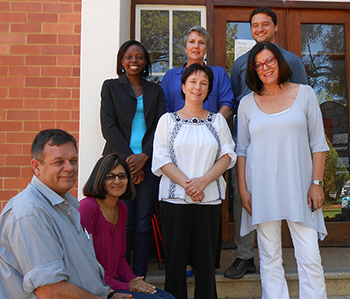Latest News Archive
Please select Category, Year, and then Month to display items
11 June 2021
|
Story Rulanzen Martin
|
Photo Courtesy of artists and the Johannes Stegmann Gallery.
![]()
Liminality is an exhibition of first-, second- and third-year student’s work in the
Department of Fine Arts at the University of the Free State (UFS). The works are from 2019 and 2020. Created during the hard lockdown of 2020, the artworks provide a glimpse of what students had to deal with and overcome during these times.
In a proposal for the exhibition, Angela de Jesus, Curator of the UFS Art Galleries, wrote: “The subtitle of the exhibition is ‘threshold, transition, transformation’ and it refers to the creative processes that students engaged with
in these adverse circumstances resulting in a wide array of artworks in both traditional and adapted mediums.”
The exhibition speaks to our shared experiences of insecurity, fragility, and discord, and to the resourcefulness and immutability of creative expression.
The virtual exhibition runs until 2 July 2021.
The exhibition is also currently available for viewing at the Johannes Stegmann Art Gallery, Sasol Library, UFS Bloemfontein Campus. Monday - Friday 09:00 - 16:00.
 MEGAN JOHNS, Battleground, Tobacco, charcoal dust, plaster of paris and resin, 93.5 x 50 x 7.5 cm
MEGAN JOHNS, Battleground, Tobacco, charcoal dust, plaster of paris and resin, 93.5 x 50 x 7.5 cm
 JACOBETH SELINGA, Linda, Installation: Found bed, wool and thread, 257 x 196 x 91 cm
JACOBETH SELINGA, Linda, Installation: Found bed, wool and thread, 257 x 196 x 91 cm
 POLOKO MOHANOE, Prayer for rain, Gouache on Fabriano, 66 x 72.8 cm
POLOKO MOHANOE, Prayer for rain, Gouache on Fabriano, 66 x 72.8 cm
 SEBOTSE SELAMULELA, In my image (Coronavirus head), Clay, 35 x 40 x 60 cm
SEBOTSE SELAMULELA, In my image (Coronavirus head), Clay, 35 x 40 x 60 cm
 WILLIAM SHAER, Creator, Deconstructed chair, koat wood and Imbura wood, 100 x 75 x 45 cm
WILLIAM SHAER, Creator, Deconstructed chair, koat wood and Imbura wood, 100 x 75 x 45 cm
 Johannes Stegmann Gallery
Johannes Stegmann Gallery
 Interior of the Johannes Stegmann Gallery
Interior of the Johannes Stegmann Gallery
Fighting the tuberculosis battle as a collective
2015-09-28

The team hard at work making South Africa a
healthier place |
Tuberculosis (TB) is second only to HIV/AIDS as the greatest killer worldwide due to a single infectious agent. More than 95% of TB deaths occur in low- and middle-income countries. Despite being more prevalent among men than women, TB remains one of the top five causes of death amongst women between the ages of 15 and 44 years. While everyone is at risk for contracting TB, those most at risk include children under the age of five and the elderly. In addition, research indicates that individuals with compromised immune systems, household contacts with pulmonary TB patients, and healthcare workers are also at increased risk for contracting TB.
According to the Deputy Director of the Centre for Health Systems Research and Development (CHSR&D) at the UFS, Dr Michelle Engelbrecht, research has found that healthcare workers may be three times more likely to be infected by TB than the general population.
The unsettling fact
“Research done in health facilities in South Africa has found that nurses do not often participate in basic prevention acts, such as opening windows and wearing respirators when attending to infectious TB patients,” she explained.
In response to this concern, CHSR&D, which operates within the Faculty of Humanities at the the University of the Free State (UFS) Bloemfontein Campus has developed a research project to investigate TB prevention and infection control in primary healthcare facilities and households in Mangaung Metropolitan.
Action to counter the statistics
A team of four researchers and eight field workers from CHSR&D are in the process of gathering baseline data from the 41 primary healthcare facilities in Mangaung. The baseline comprises a facility assessment conducted with the TB nurse, and observations at each of the facilities. Individual interviews are also conducted with community caregivers, as well as TB and general patients. Self-administered questionnaires on knowledge, attitudes, and practices about TB infection control are completed by all nurses and facility-based community caregivers.
Healthcare workers are the main focus of this research, given their increased risk of acquiring TB in healthcare settings. At clinics, interventions will be developed to improve infection control practices by both healthcare workers and patients. TB patients’ households are also visited to screen household contacts for TB. Those found to have symptoms suggesting TB infection are referred to the clinics for further assessment and treatment.
The findings of this study will serve to inform the development of an intervention to address TB prevention and infection control in primary healthcare facilities. Further funding will be sought to implement and evaluate the intervention.
Curbing future infections and subsequent deaths as a result of TB is the priority for the UFS. The cooperation and collaboration of the community, government, and sponsors will ensure that this project is a success, hence prolonging life expectancy.